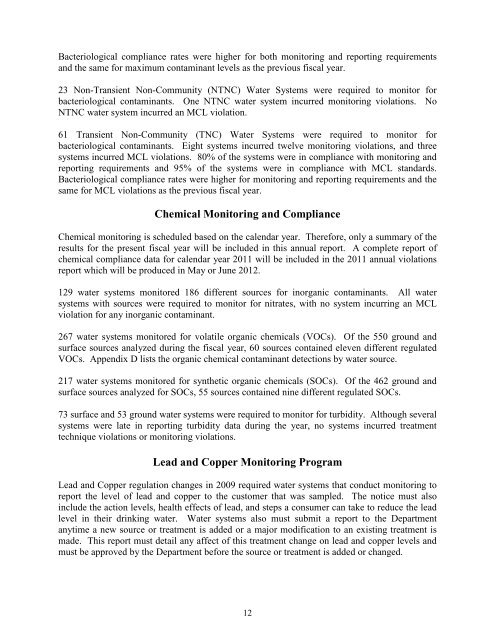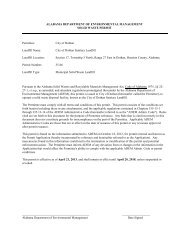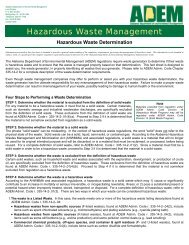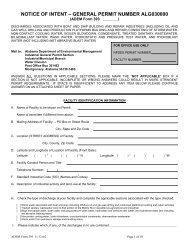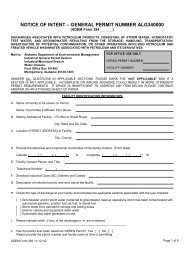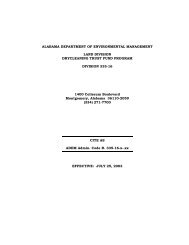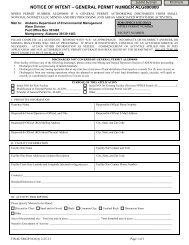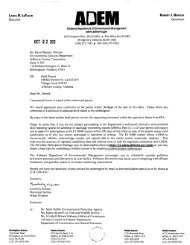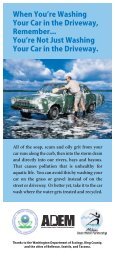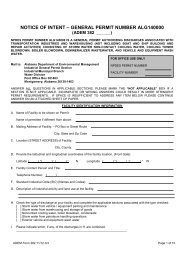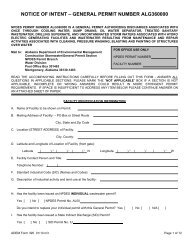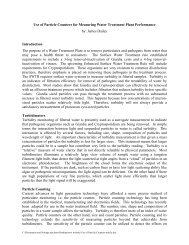drinking water branch fy2011 annual report - Alabama Department ...
drinking water branch fy2011 annual report - Alabama Department ...
drinking water branch fy2011 annual report - Alabama Department ...
Create successful ePaper yourself
Turn your PDF publications into a flip-book with our unique Google optimized e-Paper software.
Bacteriological compliance rates were higher for both monitoring and <strong>report</strong>ing requirements<br />
and the same for maximum contaminant levels as the previous fiscal year.<br />
23 Non-Transient Non-Community (NTNC) Water Systems were required to monitor for<br />
bacteriological contaminants. One NTNC <strong>water</strong> system incurred monitoring violations. No<br />
NTNC <strong>water</strong> system incurred an MCL violation.<br />
61 Transient Non-Community (TNC) Water Systems were required to monitor for<br />
bacteriological contaminants. Eight systems incurred twelve monitoring violations, and three<br />
systems incurred MCL violations. 80% of the systems were in compliance with monitoring and<br />
<strong>report</strong>ing requirements and 95% of the systems were in compliance with MCL standards.<br />
Bacteriological compliance rates were higher for monitoring and <strong>report</strong>ing requirements and the<br />
same for MCL violations as the previous fiscal year.<br />
Chemical Monitoring and Compliance<br />
Chemical monitoring is scheduled based on the calendar year. Therefore, only a summary of the<br />
results for the present fiscal year will be included in this <strong>annual</strong> <strong>report</strong>. A complete <strong>report</strong> of<br />
chemical compliance data for calendar year 2011 will be included in the 2011 <strong>annual</strong> violations<br />
<strong>report</strong> which will be produced in May or June 2012.<br />
129 <strong>water</strong> systems monitored 186 different sources for inorganic contaminants. All <strong>water</strong><br />
systems with sources were required to monitor for nitrates, with no system incurring an MCL<br />
violation for any inorganic contaminant.<br />
267 <strong>water</strong> systems monitored for volatile organic chemicals (VOCs). Of the 550 ground and<br />
surface sources analyzed during the fiscal year, 60 sources contained eleven different regulated<br />
VOCs. Appendix D lists the organic chemical contaminant detections by <strong>water</strong> source.<br />
217 <strong>water</strong> systems monitored for synthetic organic chemicals (SOCs). Of the 462 ground and<br />
surface sources analyzed for SOCs, 55 sources contained nine different regulated SOCs.<br />
73 surface and 53 ground <strong>water</strong> systems were required to monitor for turbidity. Although several<br />
systems were late in <strong>report</strong>ing turbidity data during the year, no systems incurred treatment<br />
technique violations or monitoring violations.<br />
Lead and Copper Monitoring Program<br />
Lead and Copper regulation changes in 2009 required <strong>water</strong> systems that conduct monitoring to<br />
<strong>report</strong> the level of lead and copper to the customer that was sampled. The notice must also<br />
include the action levels, health effects of lead, and steps a consumer can take to reduce the lead<br />
level in their <strong>drinking</strong> <strong>water</strong>. Water systems also must submit a <strong>report</strong> to the <strong>Department</strong><br />
anytime a new source or treatment is added or a major modification to an existing treatment is<br />
made. This <strong>report</strong> must detail any affect of this treatment change on lead and copper levels and<br />
must be approved by the <strong>Department</strong> before the source or treatment is added or changed.<br />
12


